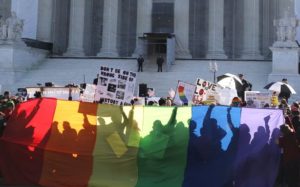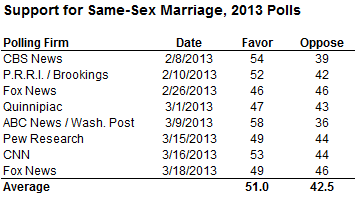 Hundreds of interested people braved the unseasonably cold temperatures in Washington, DC for days before, for the chance to be seated in the Supreme Court Chambers where oral arguments on two landmark cases on equal rights for same-sex partners are being heard this week. One case, heard Tuesday, deals with California’s controversial Proposition 8 ban on same-sex marriage and the second heard on Wednesday pertained to the Defense of Marriage Act (DOMA) where Federal law currently defines marriage as between a man and a woman for the purpose of deciding who receives federal benefits. In United States v. Windsor, the court heard arguments on whether DOMA violates the Fifth Amendment.
Hundreds of interested people braved the unseasonably cold temperatures in Washington, DC for days before, for the chance to be seated in the Supreme Court Chambers where oral arguments on two landmark cases on equal rights for same-sex partners are being heard this week. One case, heard Tuesday, deals with California’s controversial Proposition 8 ban on same-sex marriage and the second heard on Wednesday pertained to the Defense of Marriage Act (DOMA) where Federal law currently defines marriage as between a man and a woman for the purpose of deciding who receives federal benefits. In United States v. Windsor, the court heard arguments on whether DOMA violates the Fifth Amendment.
What is so interesting about these cases is that public sentiment on gay marriage has seen a sea change in attitudes over the past few years. Just 10 years ago only about 1/3 of Americans supported same-sex marriage and according to polls conducted in 2013 that number is now over 50%. While an analysis by The New York Times says that the rate of change in attitudes has been steady and has not necessarily increased at a faster pace lately, it is clear that we have reached the tipping point…a critical mass of support is evident. The chart below shows the results of polls taken this year. On average 51% support and 42% oppose Gay marriage.

With the backdrop of this changing public sentiment, the Justices are faced with deciding whether the legality of same-sex marriage should reside with the states and whether the Federal DOMA law is unconstitutional.
Based on the oral arguments heard on Tuesday, both the liberal and conservative justices seemed leery of issuing a decision that would apply to any state outside of California. Some Justices questioned why they were even hearing the case as the decision has already been struck down by lower courts in California. It seems unlikely that when the final decision on this issue is rendered in June there will be a decision that would make same-sex marriages legal across the land.
However, relative to DOMA, it appears that the majority of the Justices on the High Court may be prepared to strike down the part of the 1996 law that recognizes only marriages of opposite-sex couples for more than 1,000 federal laws and programs. Such a ruling would mandate federal benefits to married same-sex couples in the nine states, and the District of Columbia that have approved same-sex marriages.
The legal victories for our LGBT brothers and sisters have been happening all too slowly but it appears that with growing public acceptance and support, there is hope for accelerated movement. For example, ENDA (Employment Non-discrimination Act), which would ban discrimination in employment has been stalled in committee for a number of years. In February, Senator Tom Harkin of Iowa pledged to move the Employment Non-Discrimination Act through the Senate Health, Education, Labor, and Pensions Committee, which he chairs. And if Congress does not pass ENDA, President Obama may issue an executive order prohibiting discrimination on the basis of sexual orientation and gender identity, among companies that do business with the federal government.
Fort a more in-depth discussion on LGBT issues see The Global D&I Tipping Point.
Photo credit: Reuters


















